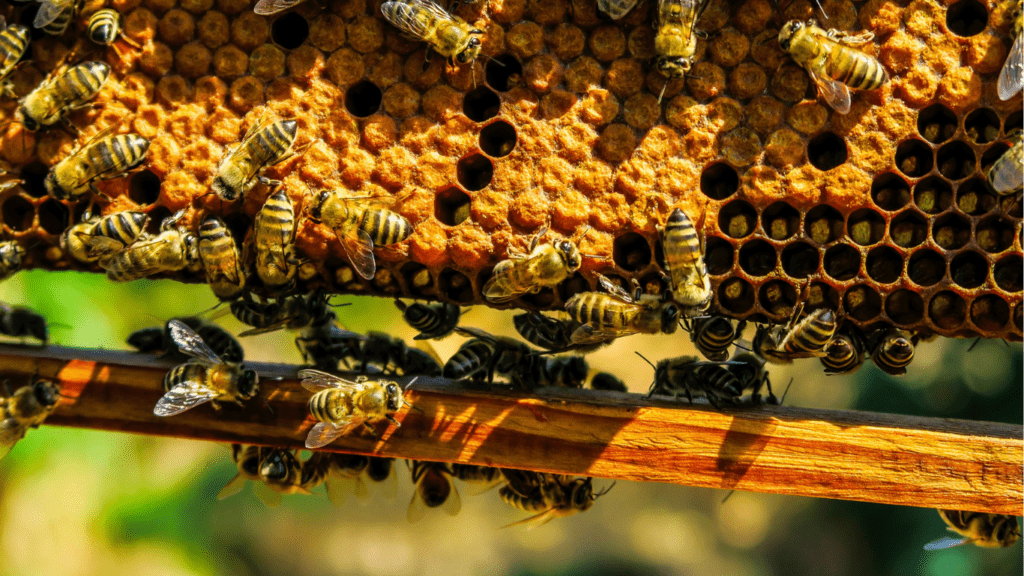The Crucial Role of Bees in the Ecosystem
Bees represent essential components of the ecosystem, offering more than just honey. They serve as primary pollinators, significantly influencing biodiversity and agriculture.
Pollination and Its Impact on Biodiversity
Pollination by bees guarantees the reproduction of plants, which affects entire ecosystems. Around 75% of the world’s flowering plants rely on animal pollinators, of which bees are the most efficient.
This process supports not only the survival of plant species but also the animals that depend on those plants for food and shelter.
Unique Plant-Pollinator Interactions
- Wildflowers: Bees enhance the genetic diversity of wildflowers, ensuring their resilience and survival.
- Trees: Many fruit and nut trees, such as apple and almond, depend on bee pollination for fruit production.
Bees and Their Role in Sustaining Agriculture
Agriculture constantly benefits from bee pollination, which enhances crop yields and quality. Over 35% of global food crops depend on pollinators, ensuring stable food supplies.
Without bees, many fruits, vegetables, nuts, and seeds would become scarce and far more expensive.
- Crop Yield: Pollination by bees improves both the quantity and quality of around 100 commercial crops, including blueberries, tomatoes, and cucumbers.
- Market Value: Pollinated crops contribute substantially to the economy. For instance, bees’ pollination services in the United States add an estimated $15 billion in value annually.
Bees’ ecological and economic roles highlight their irreplaceable contribution to both wild and managed environments.
Threats Facing Bee Populations
Bee populations face numerous threats, significantly impacting their survival and, consequently, ecosystems and agriculture.
Habitat Loss and Its Effects
Urbanization, deforestation, and agricultural expansion contribute to habitat loss. When habitats shrink, bee nesting sites and floral resources disappear, reducing bee populations.
For example, wildflower meadows and hedgerows, critical for bees, are often replaced by monoculture crops that provide limited nourishment. Habitat fragmentation also impedes bees’ ability to forage and migrate, leading to isolated gene pools and lower resilience.
Pesticides and Their Impact on Bee Health
Pesticides, especially neonicotinoids, weaken bee health. These chemicals, designed to target pests, often affect non-target species like bees. Exposure to pesticides can cause disorientation, weakened immune systems, and impaired foraging behavior.
Studies have shown that neonicotinoids impact bees’ ability to navigate back to their hives and reduce colony size. Chronic exposure also makes bees more susceptible to parasites and diseases.
Climate Change and Its Implications for Bees
Climate change disrupts bees’ natural behaviors and habitats. Rising temperatures, altered precipitation patterns, and extreme weather events affect floral resources and nesting conditions.
For instance, earlier blooming seasons can lead to mismatches between flower availability and bee foraging times, reducing food sources. Changes in temperature and weather patterns also affect bees’ hibernation cycles and migration routes, making survival more challenging.
How to Support Bee Populations

Protecting bee populations is crucial for biodiversity and agriculture. There are several practical steps individuals and communities can take to help support bees.
Creating Bee-Friendly Gardens
Plant diverse native flowers to attract and sustain bees. Include plants such as sunflowers, lavender, and clover that provide nectar and pollen. Avoid using pesticides, as they harm bees. Instead, opt for natural pest control methods like introducing beneficial insects.
Provide water sources like shallow dishes with stones for bees to land on. Maintain blooming plants throughout the seasons to ensure bees have food year-round.
Supporting Sustainable Farming Practices
Purchase organic produce to support farmers avoiding harmful pesticides. Encourage local farmers to use integrated pest management (IPM), reducing chemical use. Support farms practicing crop rotation and diversifying crops to improve habitat and food sources for bees.
Promote agroforestry, which integrates trees and shrubs into farmland, creating more diverse environments beneficial to bees.
Advocacy and Education
Participate in local conservation efforts and campaigns to protect habitat.
- Educate neighbors on the importance of bees and encourage bee-friendly practices.
- Engage in citizen science projects to monitor and support bee populations.
- Advocate for policies reducing pesticide use and protecting natural habitats.
- Support organizations working towards bee conservation and sustainability.
By taking these actions, we can collectively improve the health and sustainability of bee populations, ensuring they continue to thrive and support our ecosystems.


 is a committed writer and environmental advocate at Eco Elegance Technique, specializing in sustainable practices, health, and wellness. With a background in environmental studies, Peter focuses on providing readers with practical advice on integrating eco-friendly habits into their daily routines. His work aims to inspire a deeper connection between personal well-being and environmental responsibility, making sustainability accessible and actionable for everyone.
is a committed writer and environmental advocate at Eco Elegance Technique, specializing in sustainable practices, health, and wellness. With a background in environmental studies, Peter focuses on providing readers with practical advice on integrating eco-friendly habits into their daily routines. His work aims to inspire a deeper connection between personal well-being and environmental responsibility, making sustainability accessible and actionable for everyone.
